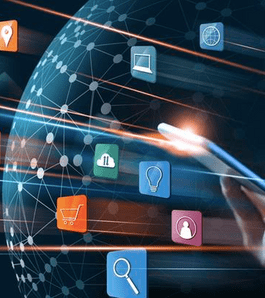14 Benefits of SaaS as a Business Model
Dan Cattermole, CEO, Yozobi
Are you thinking of developing a SaaS product for your existing business? Are you considering starting up a new UK business based around SaaS?
We have researched the benefits of the SaaS business model.
Read on to find out if you were fully aware of all the benefits of software as a service (SaaS).
The SaaS business model defined
SaaS is an abbreviation for software as a service, and a SaaS business model defines as the sale of cloud-based software through a subscription paid monthly or annually. The end-user or customer accesses a SaaS product or service via a desktop, a mobile app, or a web app.
SaaS solutions can serve customers (B2C) or businesses (B2B). SaaS businesses that solve problems in the B2B markets can grow quickly and predictably whereas B2C SaaS can be harder to create something of value as consumers expect apps to be low cost or free.

The benefits of the software as a service business model
1. Recurring revenue
Instead of a reliance on one-off transactions or upfront fees, SaaS builds around a smaller subscription-based transaction recurring on a monthly or annual basis. Recurring revenue is what is so effective for SaaS providers. As your product becomes integral to the operations of your customers, they are more likely to remain loyal and retain subscriptions for the long term.
It leads to consistent monthly revenue from subscriptions; once you acquire a new user for your software, you do not have to worry about one-off sales every month which is the case for the traditional licensed software model.
2. Multiple revenue streams
Subscription fees are not the only way to generate revenue for a SaaS Company. Once a SaaS business has prioritised selling a core subscription plan and understands which marketing channels provide a favourable user acquisition cost, it can explore other revenue streams:
- Additional fees for further data processing or increased storage
- Further fees for API access
- An additional charge for any custom integrations
- Additional services inside a SaaS platform including book-keeping, design work or other services
- Additional services for hands-on implementation, usually at the enterprise level.
3. Predictability and measurability
SaaS software enables the collection of essential data about users, including what they do in an app, how they use the service and when they cancel a service. The data facilitates ongoing product optimisation, including packaging and pricing, to assist with customer retention.
The SaaS software as a service model allows for the effective use of metrics to measure growth and performance. Metrics are useful for sales strategies, product development and process changes. Essential analytics for SaaS companies include:
Churn rate
The churn rate shows the number of customers that unsubscribe or leave during a specific period and will tell you about the level of customer satisfaction. If it is continually rising, it is a negative sign for your business.
Customer Lifetime Value CLV
A calculation of the average revenue you receive from a customer during the period they have subscribed to your software.
Monthly recurring revenue MRR
A measurement of the expected revenue per month which helps to understand the month on month variations in income.
The average revenue per account ARPA
It is a metric which shows how revenue derives from a single client typically on a monthly, quarterly, or yearly basis.
4. Lower costs
Cost-effectiveness is a key advantage of the SaaS business model. The SaaS model only needs to take care of supporting the SaaS product on different web browsers and applications. It contrasts to traditional software installation, which requires supporting multiple devices, operating systems, and local device issues.
For SaaS customers, it allows an individual end user or small and medium businesses to use software that previously would be out of reach due to the high cost of a licence.
5. Ease of use for customers
With SaaS, there is no complicated software to install and figure out. Unlike the traditional model, in SaaS, the software is already installed and configured. A user can log in using their online account credentials. They are provided with instant onboarding and can start using an application straight away.
The SaaS business model also makes it straightforward to offer free trials which are essential, as try before you buy reduces risk for the buyer. By having the first-hand experience, whether a product is suitable allows a user to become a paying customer by signing up for a paid plan.

6. Network effects
It is highly likely that you will not hear about good SaaS applications from a sales call; it is more likely to be through word of mouth. The network effect is a crucial goal for a SaaS business. Satisfied customers will recommend a SaaS product to others, and the product starts to experience organic growth. It can, in some circumstances, lead to a product going viral.
7. Accessibility
SaaS allows users to access a service anytime on any device from any location if there is an internet connection. It gives user independence and mobility when working with the software. It contrasts with licensed software with a license often limited to a specific number of devices with limited use on a different computer.
10. Low barrier to entry
The SaaS business model has removed barriers to entry for software, allowing startups to enter a wide range of niches. Anyone who has substantial knowledge of a niche or sector can launch a SaaS company. With the widespread availability of software developers in the UK capable of building a SaaS product, the technical constraints of developing a SaaS business falls.
11. Flexible licence arrangements
The SaaS model of subscription-based software works well for the needs of the customer. It provides flexible monthly subscription periods allowing a customer to sign up for as long as they need. There is no requirement for a user to install software or purchase a licence. Microsoft, with its Office product, is an example of a business that has moved from a licensing model to a subscription model.
12. Automated updates
Being hosted in the cloud means software updates for SaaS only need to be implemented from the service provider end. A customer will always have the most up to date version with the latest features from periodic incremental updates typically built into the subscription price.
It contrasts to licensed software installed on a computer that requires the customer to make sure updates are complete.
As a SaaS service is managed from one infrastructure, new releases and fixes can be pushed out quickly with shorter maintenance windows resulting in shorter downtime. Rapid responsiveness and product improvements, in turn, help improve customer loyalty.

13. Cloud Deployment
SaaS cloud deployment refers to the delivery and installation of software as a service. It contrasts with the traditional on-premise software deployment and associated issues with installation and configuration and servers.
A SaaS business provides membership to the end-user by giving them access to a SaaS product via website account credentials. The end-user only needs internet connectivity and a web browser to access the SaaS service.
14. Internet piracy
A SaaS business does not sell a license for software use; it instead uses a subscription model. The cloud becomes a platform for data which restricts access to subscribers of the software. By controlling software and keeping it in the cloud helps reduced piracy.
Conclusion
SaaS, as a business model, has come to be loved by customers and tech investors alike. For customers, access to software, previously only available with expensive one-off licenses can now be accessed when needed with a subscription services model. For service providers recurring revenue allows further development of the product.



